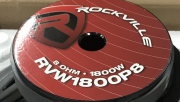Right now I am running a Crown CL1 275W per channerl @ 8ohm for my subs but thinking I will eventually replace that amp with a Carver pm 1.5 that is 450W per channel @ 8ohm.... You used 3/4 mfd for your cabs?? I was looking at best way to do the circle cut out for the speaker. I read that the problem with a router bit on thick mfd is the bit dulls real fast. I plan to cut one so the woofer will mount to it then cut another one a bit larger glue it to the the panel with the smaller hole so the woofer will look recessed so that will be 4 large holes all together for the 2 cabs. Not sure the cost of a router bit to do this but I assume up near $30 so it could get pricey if I have to buy 3 or 4 bits....
Yes 3/4” MDF.
I used a router for these cabinets although I did use a jig saw for the previous 18” build. I cut all the driver holes (8) and all the port holes (16) with one carbide tipped bit. I used the protective 1/4” sheet that came with my lift of MDF (ask the hardware store for a piece from scrap maybe?) and made a template out of it. It had a hole that was large enough that the router sat inside and the body of the router ran around the inside of that hole, cutting the required diameter for the speaker. For the ports I used a circle cutting attachment. You can make one from that piece of 1/4” scrap. If you make your own circle cutter, you can make it big enough to do the 18” holes. I did it this way as I also used that template for my screw holes.
I clamped the face boards to an old wooden door as a sacrificial work bench, then screwed the soon to be cut out circle down so it wouldn’t move when separated, run the router around plunging about 1/4” deep each time. Then I removed the two screws holding the off cut and was Left with a nice hole.
The jig saw worked ok, not as nice of a circle but I’m covering that with trim rings... I did the low-max build as you plan to with the double face boards with a jig saw. Used a couple blades and took a couple hours including breaks for “refreshments” which might be why the holes weren’t as round as the router/jig method.
The hardest part of the double face boards (I was a dummy) was the port holes. I used a hole saw through both layers. Had to peck at it and blow the cut clear with air. If I did it again I would cut an oversized hole in the inner board then cut the hole in the face board before laminating them. Use lots of glue and spread it around so you have no voids. Use lots of screws on the lamination at least until it dries.
I used plain old cardboard sono tube for port material on the big build, and 4” sewer pipe (PVC) for the low max. Either works fine. Use a fine hacksaw to cut the sono tube or you’ll fray the cardboard. That’s no big deal though just rub some wood glue with a rag around he cuts to fix that then sand or 1/4 round the edge at the face board.
You probably want a 6” ID port if you can swing it. Usually 1/3 of the speaker diameter is a good rule of thumb to keep port air velocity low enough to not chuff but not so big it has unwanted resonances. A larger port has to be longer in length for the same tuning so you might run into trouble if rhenpirt wont fit in the box. Remember that the driver displacement, bracing and the volume occupied by the port all come off your Vb for calculations.
These speakers are fairly stiff and I found it hard to visually see resonance when testing the cabinets, pick up a shunt resistor and use your MM to check resonance frequency before you glue the ports in for good.
Good luck!

